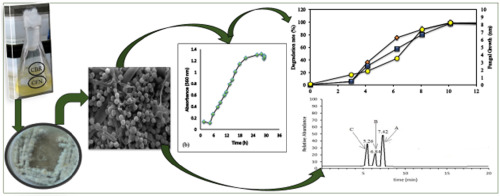当前位置:
X-MOL 学术
›
Chemosphere
›
论文详情
Our official English website, www.x-mol.net, welcomes your
feedback! (Note: you will need to create a separate account there.)
Bioremediation process optimization and effective reclamation of mixed carbamate-contaminated soil by newly isolated Acremonium sp.
Chemosphere ( IF 8.1 ) Pub Date : 2020-01-23 , DOI: 10.1016/j.chemosphere.2020.125982 Parminder Kaur 1 , Chandrajit Balomajumder 1
Chemosphere ( IF 8.1 ) Pub Date : 2020-01-23 , DOI: 10.1016/j.chemosphere.2020.125982 Parminder Kaur 1 , Chandrajit Balomajumder 1
Affiliation

|
Global pollution from excessive pesticide use has become a serious environmental and public health problem. The aim of the study was to optimize the fungal mediated simultaneous removal of carbofuran and carbaryl from soil. Carb-PV5 strain was isolated from contaminated soil following enrichment culture technique; based on 18S rRNA sequencing, strain was identified as Acremonium sp. (MK514615); Field Emission Scanning Electron Microscopic analysis reflected its morphology. Towards the development of bioaugmentation strategy for the bioremediation of carbamate-contaminated soil, the process parameters were optimized employing Central Composite Rotatable Method. The experimental studies were performed in the range of biomass (0.2-0.6 g kg-1), temperature (23-33 °C), pH (6-9) and moisture (10-30%). The degradation rate parameters, k and t1/2 were determined to as 0.475, 0.325 d-1 and 5.39, 2.1 d with the corresponding r2 of 0.9491, 0.9964 for zero and first order, respectively. The cube root growth kinetic constant k of Acremonium sp. varied from 0.0469 to 0.0512 (g1/3 L-1/3 h-1) and 0.0378 to 0.0415 (g1/3 L-1/3 h-1) for carbofuran and carbaryl, respectively. To confirm the model appropriacy and sustainability of the optimization procedure, bioremediation experiments were conducted onto real carbamate-contaminated soils. UPLC and GCMS analysis confirmed the successful removal of carbamates. The current study presents the first report on the bioaugmentation studies carried out on the mixed carbamate contaminated soil using newly isolated Acremonium sp.
中文翻译:

新分离出的Acremonium sp。的生物修复工艺优化和有效处理混合氨基甲酸酯污染的土壤。
过量使用农药造成的全球污染已成为严重的环境和公共卫生问题。该研究的目的是优化真菌介导的同时从土壤中去除呋喃丹和西维因的方法。采用富集培养技术从污染的土壤中分离出Carb-PV5菌株。根据18S rRNA测序,菌株被鉴定为Acremonium sp。(MK514615); 场发射扫描电子显微镜分析反映了其形态。为了发展对氨基甲酸酯污染土壤进行生物修复的生物强化策略,采用中心复合旋转法对工艺参数进行了优化。在生物质(0.2-0.6 g kg-1),温度(23-33°C),pH(6-9)和水分(10-30%)的范围内进行了实验研究。退化率参数 k和t1 / 2被确定为0.475、0.325 d-1和5.39、2.1 d,零级和一阶的相应r2分别为0.9491、0.9964。Acremonium sp。的立方根生长动力学常数k。呋喃丹和西维因分别在0.0469至0.0512(g1 / 3 L-1 / 3 h-1)和0.0378至0.0415(g1 / 3 L-1 / 3 h-1)之间变化。为了确认模型程序的适当性和优化程序的可持续性,对真实的氨基甲酸酯污染的土壤进行了生物修复实验。UPLC和GCMS分析证实成功去除了氨基甲酸酯。当前的研究是有关使用新分离的Acremonium sp对混合氨基甲酸酯污染的土壤进行的生物强化研究的第一份报告。分别。Acremonium sp。的立方根生长动力学常数k。呋喃丹和西维因分别在0.0469至0.0512(g1 / 3 L-1 / 3 h-1)和0.0378至0.0415(g1 / 3 L-1 / 3 h-1)之间变化。为了确认模型程序的适当性和优化程序的可持续性,对真实的氨基甲酸酯污染的土壤进行了生物修复实验。UPLC和GCMS分析证实成功去除了氨基甲酸酯。当前的研究是有关使用新分离的Acremonium sp对混合氨基甲酸酯污染的土壤进行的生物强化研究的第一份报告。分别。Acremonium sp。的立方根生长动力学常数k。呋喃丹和西维因分别在0.0469至0.0512(g1 / 3 L-1 / 3 h-1)和0.0378至0.0415(g1 / 3 L-1 / 3 h-1)之间变化。为了确认模型程序的适当性和优化程序的可持续性,对真实的氨基甲酸酯污染的土壤进行了生物修复实验。UPLC和GCMS分析证实成功去除了氨基甲酸酯。当前的研究是有关使用新分离的Acremonium sp对混合氨基甲酸酯污染的土壤进行的生物强化研究的第一份报告。为了确认模型程序的适当性和优化程序的可持续性,对真实的氨基甲酸酯污染的土壤进行了生物修复实验。UPLC和GCMS分析证实成功去除了氨基甲酸酯。当前的研究是有关使用新分离的Acremonium sp对混合氨基甲酸酯污染的土壤进行的生物强化研究的第一份报告。为了确认模型程序的适当性和优化程序的可持续性,对真实的氨基甲酸酯污染的土壤进行了生物修复实验。UPLC和GCMS分析证实成功去除了氨基甲酸酯。当前的研究是有关使用新分离的Acremonium sp对混合氨基甲酸酯污染的土壤进行的生物强化研究的第一份报告。
更新日期:2020-01-23
中文翻译:

新分离出的Acremonium sp。的生物修复工艺优化和有效处理混合氨基甲酸酯污染的土壤。
过量使用农药造成的全球污染已成为严重的环境和公共卫生问题。该研究的目的是优化真菌介导的同时从土壤中去除呋喃丹和西维因的方法。采用富集培养技术从污染的土壤中分离出Carb-PV5菌株。根据18S rRNA测序,菌株被鉴定为Acremonium sp。(MK514615); 场发射扫描电子显微镜分析反映了其形态。为了发展对氨基甲酸酯污染土壤进行生物修复的生物强化策略,采用中心复合旋转法对工艺参数进行了优化。在生物质(0.2-0.6 g kg-1),温度(23-33°C),pH(6-9)和水分(10-30%)的范围内进行了实验研究。退化率参数 k和t1 / 2被确定为0.475、0.325 d-1和5.39、2.1 d,零级和一阶的相应r2分别为0.9491、0.9964。Acremonium sp。的立方根生长动力学常数k。呋喃丹和西维因分别在0.0469至0.0512(g1 / 3 L-1 / 3 h-1)和0.0378至0.0415(g1 / 3 L-1 / 3 h-1)之间变化。为了确认模型程序的适当性和优化程序的可持续性,对真实的氨基甲酸酯污染的土壤进行了生物修复实验。UPLC和GCMS分析证实成功去除了氨基甲酸酯。当前的研究是有关使用新分离的Acremonium sp对混合氨基甲酸酯污染的土壤进行的生物强化研究的第一份报告。分别。Acremonium sp。的立方根生长动力学常数k。呋喃丹和西维因分别在0.0469至0.0512(g1 / 3 L-1 / 3 h-1)和0.0378至0.0415(g1 / 3 L-1 / 3 h-1)之间变化。为了确认模型程序的适当性和优化程序的可持续性,对真实的氨基甲酸酯污染的土壤进行了生物修复实验。UPLC和GCMS分析证实成功去除了氨基甲酸酯。当前的研究是有关使用新分离的Acremonium sp对混合氨基甲酸酯污染的土壤进行的生物强化研究的第一份报告。分别。Acremonium sp。的立方根生长动力学常数k。呋喃丹和西维因分别在0.0469至0.0512(g1 / 3 L-1 / 3 h-1)和0.0378至0.0415(g1 / 3 L-1 / 3 h-1)之间变化。为了确认模型程序的适当性和优化程序的可持续性,对真实的氨基甲酸酯污染的土壤进行了生物修复实验。UPLC和GCMS分析证实成功去除了氨基甲酸酯。当前的研究是有关使用新分离的Acremonium sp对混合氨基甲酸酯污染的土壤进行的生物强化研究的第一份报告。为了确认模型程序的适当性和优化程序的可持续性,对真实的氨基甲酸酯污染的土壤进行了生物修复实验。UPLC和GCMS分析证实成功去除了氨基甲酸酯。当前的研究是有关使用新分离的Acremonium sp对混合氨基甲酸酯污染的土壤进行的生物强化研究的第一份报告。为了确认模型程序的适当性和优化程序的可持续性,对真实的氨基甲酸酯污染的土壤进行了生物修复实验。UPLC和GCMS分析证实成功去除了氨基甲酸酯。当前的研究是有关使用新分离的Acremonium sp对混合氨基甲酸酯污染的土壤进行的生物强化研究的第一份报告。











































 京公网安备 11010802027423号
京公网安备 11010802027423号